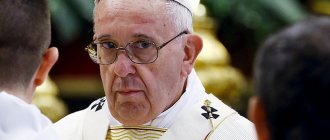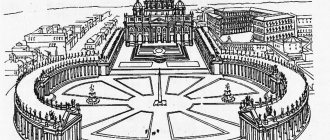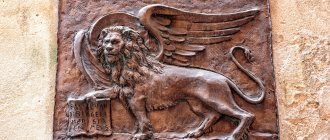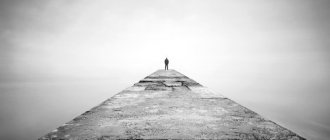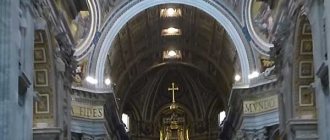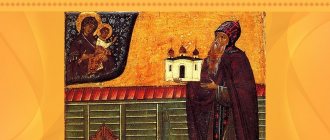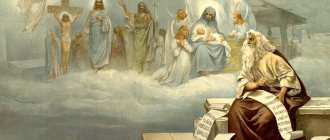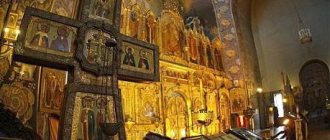Title of the Pope
The title Pope was originally used by some Christian churches to identify the highest clergy.
Now the Pope is the head of the Roman and Eastern Catholic Church . Officially, the position began to be called that way with the Pontiff of Siricius (384).
It is curious that any unmarried male Catholic under the age of 80 can be a candidate, but in practice for the last few centuries a cardinal or bishop has become a candidate.
The powers and responsibilities of governance extend to the entire Catholic Church as well as its administration. The Pope is an independent subject of law; all branches of government in the Vatican are subordinate to his authority.
Powers of the ruler
Endowed with supreme spiritual and legal authority, the pontiff fulfills the following duties before the people and the church:
- Must be a Christian and help spread the faith.
- Carries out administrative management of the church.
- Publishes canons.
- Appoints priests to positions.
- Assigns church ranks.
- Convenes the World Council and approves its decisions.
- Manages the judiciary on matters of marriage, monastic vows and theological teaching in schools.
As a spiritual leader, the pope must be an example for all Catholics in the world, as well as contribute to the history of the development of the papacy and the church.
How is the election of a pontiff carried out?
The pope is elected for life. He can leave his post only due to death, as well as in case of abdication.
To elect a new pontiff, a conclave is convened in the Sistine Chapel - a council consisting of cardinals. Council members cannot discuss elections outside of the chapel.
Each voting participant receives his own ballot, where he must write in block letters for whom he votes. Everything is arranged in such a way that it is impossible to determine for whom this or that cardinal voted. The ballot is placed in a special ballot box.
If after voting the number of sheets in the ballot box does not match the number of voters, then all ballots are burned without being read. Ballots are burned even after votes are counted.
For a candidate to lead the church, he must receive two-thirds plus one vote.
All Catholics in the world are watching the election of the Pope. Smoke over the Sistine Chapel, a consequence of the burning of ballots, becomes a kind of sign of the end of the procedure. If it is black, then the pontiff has not been elected and the conclave will continue, and white smoke is a sign of the successful completion of the elections.
The proclaimed pope, according to tradition, chooses the name by which he will be called as the supreme ruler. It is recorded in a special document. After registration, the pontiff goes to the “weeping room”, where he puts on clothes: a white cassock with a white pileolus and a cape with a hood on his head (mozzetta), and also dresses in a red embroidered table and goes out to the cardinals in the chapel. There he receives signs of respect from them.
After the congratulations, the cardinal-protodeacon goes out to the central loggia of the Basilica of St. Peter and announces to the citizens the election of a new sovereign of the capital.
From the day of his election, the Apostolic Palace in the Vatican becomes the permanent residence of the Pope.
Is it possible to read the so-called “holy fathers-hereseologists”? Aren't they heretics?
On the contrary, “heresologists” are those holy fathers and teachers of the Church who fought against heresies: St. Irenaeus of Lyons, Hippolytus of Rome, Epiphanius of Cyprus, Clement of Alexandria and others.
As for the heresiarchs, their creations are not a secret; they are easily accessible for scientific or missionary purposes. As for curiosity, does it make sense to waste time on spiritually harmful reading if there is a sea of spiritually beneficial things?
History of the Papacy
The history of the papacy is a period of 1700 years. During this time, the institute experienced formation, decline and persecution, as well as periods of strengthening the faith and status of the Catholic Church.
The entire history of formation can be divided into the following periods:
- Pre-Nicene period I-III centuries. . The emergence of the papacy. In the archives of the Vatican, manuscripts from those times have been preserved, which speak of the first persons who bore the title of high priest. This was a difficult time for Christian communities, since the Christian religion was then outlawed. Followers of the faith were persecuted by the state and the common people; many adherents of Christianity were executed and died as martyrs.
- Formation of the institution of the papacy 313 to 493. An episcopate was created within the Roman province. Christianity became the state religion of the Roman Empire under Emperor Constantine (306−337), and sacrifices were prohibited. In 313, a law on freedom of religion was issued.
- Ostrogothic period. Lasted until 537. The Roman Empire is being ravaged by the barbarian tribes of the East Germans and Christians are being persecuted. Therefore, this period is characterized by the decline of culture and the church.
- Byzantine period. Lasted from 537 to 752. The importance of the papacy is increasing. After long wars, Italy was devastated, Rome suffered especially. The church remained the only economic support of the state, and the pope and bishops were the most competent in matters of governing the country.
- Frankish period. Lasted until 857. Christianity is the dominant religion in the Roman Empire. The Roman pontiffs assumed more and more political and administrative functions and became virtually sovereign.
- The era of papal humiliation - 1044-1048. The Vikings, who captured and plundered many European lands, despised the Christian religion.
- Strengthening the power of the Catholic Church from 1048 to 1257. The period was characterized by a conflict between the pope and the emperor over the election of bishops. Election rules and procedures developed during this period and became the basis of the modern conclave. The most significant figure of the era was Pope Urban II. He organized the Crusades and contributed to the creation of monastic orders of knighthood. The Crusades strengthened the power of the pope and gave him the opportunity to dictate terms to European monarchs.
- A period of instability, reform and great schism. Lasted from 1257 to 1585. The Pope ceased to be the sole head of the church, church discipline fell, and dissatisfaction with the clergy among citizens increased. During this unstable time, one of the important events for history took place - the Gregorian calendar was introduced by Pope Gregory XIII.
- The Age of Enlightenment from 1585 to 1689. The flourishing in the field of culture and education takes on a threatening character for religion. Protestants refuse to recognize the authority of the church, this leads to people's indifference to religion. This era can be characterized as a weakening of the theological concept of power.
- The era of modern times in the history of the papacy. For quite a long time the church lost its independence. This was facilitated by Clement XIV, who liquidated the Jesuit order and advocated the reconciliation of secular and ecclesiastical authorities, as well as Pius VII, who signed an agreement with Napoleon on state intervention in church affairs. Only in 1929 was Pius XI able to regain his status as the country's sovereign.
Now the Supreme Pontiff has confidently secured the role of head of state.
List of Popes
The Vatican publishes annually the Pontifical Yearbook in Italian. It contains information about all officials and institutions of the Roman Catholic Church. In the yearbook you can see a complete list of popes and the years of their reign, listed in chronological order under their serial number, starting with St. Peter.
Antipopes are also recorded in the register - this is the name given to people who illegally occupied the papal throne. Since the church does not recognize antipopes, their names are included in the official list, but not under a serial number, but in brackets.
A list and chronology of popes can be seen in St. Peter's Basilica in the Vatican, one of the largest Catholic Churches. A marble slab with the names of the pontiffs buried in the cathedral is located at the entrance to the sacristy of the church.
Was the woman a dad?
Pope Joan is one of the mysteries in the history of the papacy. Scientists are still arguing about the veracity of the events that took place at that time.
Ancient chronicles tell of the reign of the church by a young female pope named John VIII in the 9th century. According to sources, her reign lasted 2 years, 5 months and 4 days, and it could have continued if Joanna had not become pregnant. The deception was revealed when she went into labor during a religious procession on Easter.
After Joan's death in 857, the Vatican began a tradition of examining the new pope to make sure he was a man.
Is it possible to call a priest “holy father”?
Such an appeal to priests is not accepted in the Orthodox Church. We call canonized saints holy fathers. You can say, for example: “The Holy Fathers teach...” or “The Holy Fathers established such and such rules regarding fasting...”. The accepted address to a living priest is: “father + <name>”, for example “Father Peter”, “Father Sergius”, etc.
***
Metropolitan Hilarion (Alfeev): “What is the most applicable of the heritage of the fathers for modern life? Preserving oneself in this constantly changing world, preserving the ideals and principles of Christian life in everyday life. Every day, every hour puts us before a moral choice: to act according to the commandments or according to the spirit of this world. This is where we need to apply the experience of the holy fathers in order to protect our souls from temptations. This is what is most applicable.”
prot. Georgy Florovsky: “It is not enough to simply select quotes, taking them out of context and ignoring the circumstances under which this or that essay was written. Many of the “sayings of the Fathers” have a specific polemical orientation: they, pronounced “on occasion,” must be used with the greatest caution and accuracy. We can establish the true meaning of each remark only from the context, taking into account the author’s holistic worldview.”
Current Supreme Pontiff
The current Pope's name is Francis. The worldly name is Jorge Mario Bergoglio. He is Argentine by nationality and was previously the Archbishop of Buenos Aires.
short biography
The future head of the Vatican was born on December 17, 1936. He was the eldest of five children in the family. His father worked on the railroad, and his mother was a housewife and raised children.
Already in childhood, the boy was distinguished by kindness and courtesy. After graduating from school, he entered a technical college to become a chemist, where he successfully defended his diploma. Then he got a job in his specialty in a chemical laboratory.
At the age of 21, he suffered severe pneumonia, which almost ended in his death. After illness, I decided to devote my life to serving God.
In 1958 he joined the Society of Jesus.
He studied at his hometown's St. Joseph's College and received a degree in philosophy and a teaching license in 1967. Afterwards he taught at Catholic educational institutions in the capital and Santa Fe.
Became a priest at the age of 33 , continued his spiritual studies at the University of Alcalá de Henares and graduated in 1971.
In 1973, he took a vow of submission to the Pope and received the title of Provincial Superior of Argentina.
He was recognized as an auxiliary bishop of the capital in 1992, and after some time he was consecrated bishop.
By 1998 he became cardinal priest of the Cathedral of San Roberto Bellarmino. In this position, he received a post in the administration of the Holy See and the Vatican - in the Roman Curia.
From 2005 to 2011 he was the head of the country's Bishops' Conference.
In 2013, the Catholic world was shocked by the news of the abdication of the then-current pontiff Benedict XVI. On this occasion, a conclave was held, where Jorge Mario Bergoglio was elected as the new ruler of the Vatican. He chose Francis, the patron saint of the poor, as his new name.
Significant Events
Pope Francis is close to the people, as evidenced by his actions:
- Not yet being Supreme Pontiff, in 2001 he personally visited a hospital where poor people were dying of AIDS.
- In 2016, a significant meeting took place with Patriarch Kirill. For the first time since the great schism, a document was signed calling for pan-Christian unity.
- In 2022, Francis delivered a report against the death penalty. His initiative was supported by the governor of New York.
The current Pope is loved by the people. As a versatile and wise ruler, he opposes social inequality and believes that all people are worthy of respect.
Catholics hope that his reign will bring prosperity to the country and strengthen people's faith in God.
Finally...
Pope Gregory remains strict, honest and logical in the memory of many people. He always did good deeds, gave alms, took care of the suffering and unfortunate. He received beggars in his house, and also ordered that the income from church properties be used for their maintenance. There is evidence that when Gregory had nothing to donate, he gave a silver dish on which vegetables were served to a beggar. Currently, the name of Father Gregory is combined with the word “Great”; he is revered at all times.
